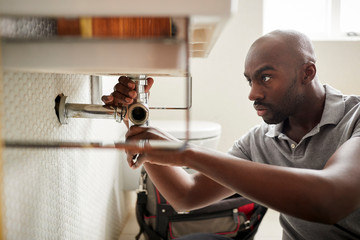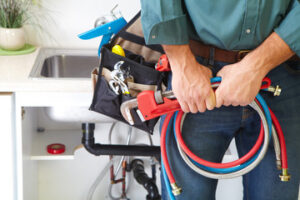Residential plumbers perform a variety of maintenance and repair tasks in homes. This includes repairing leaks, fixing toilets and drains, and maintaining water heaters. When looking for a plumber, ask friends and family for recommendations. This will help ensure you find a plumber with a good reputation who provides quality work.
 A Residential Spring TX Plumber installs plumbing systems and pipes for new construction homes and repairs existing plumbing. They use their skills to interpret blueprints and building specifications to draw a map layout, assemble pipe sections, tubing, and fittings, and solder, braze or weld them together. These professionals must also know how to use various tools and equipment, such as power drain snakes, cameras, hand and power tools, soldering irons and welding equipment, and how to read schematic drawings, blueprints, engineering specifications and crane signals.
A Residential Spring TX Plumber installs plumbing systems and pipes for new construction homes and repairs existing plumbing. They use their skills to interpret blueprints and building specifications to draw a map layout, assemble pipe sections, tubing, and fittings, and solder, braze or weld them together. These professionals must also know how to use various tools and equipment, such as power drain snakes, cameras, hand and power tools, soldering irons and welding equipment, and how to read schematic drawings, blueprints, engineering specifications and crane signals.
They can also be responsible for water supply lines, waste and vent lines and all fixtures associated with the water system in the house, including garbage disposals and hot and cold water heaters. This includes ensuring that water and gas supply lines are properly connected to each fixture and that each is functioning correctly. They can also be responsible for setting up and testing all backflow preventers and meters in the home.
Residential plumbers also work on remodeling jobs, rewiring and updating old and outdated systems in older houses to improve efficiency or for aesthetics. This type of plumbing requires them to have a good eye for detail as they must ensure that each fixture and piece of pipe is the correct size and fits properly in order for the system to function at its best.
Commercial plumbers focus on plumbing systems in office buildings, hospitals, hotels and restaurants. They may have to deal with more complex plumbing systems that are used by hundreds of people daily, which is why they need to be familiar with a wide range of plumbing issues and their solutions. These plumbers must be able to troubleshoot problems quickly and efficiently so they can repair them before the situation worsens.
It’s not uncommon for them to work on-call shifts and be called out to fix emergency plumbing situations outside of normal business hours. This involves them having to be able to solve problems in the least amount of time possible and be a good communicator with their employer or client. They are often required to have certain certifications like a Master Plumber license and must complete continuing education courses to keep their knowledge current.
The plumbing system in a residential building includes pipes that carry water and gas into a home. Plumbers also install and repair fixtures such as sinks, toilets, bathtubs, showers, dishwashers and washing machines. Many plumbers gain experience working as apprentices for more experienced plumbers. The work can be dangerous, so it is important to hire a plumbing company with workers’ compensation and liability insurance.
If a homeowner has a plumbing problem, they need to call a plumber immediately. The plumber will diagnose the issue and then determine what parts need to be replaced or fixed. The plumber will then give the homeowner a cost estimate before beginning any work. The plumber may need to dig or break into walls or ceilings to locate the source of the problem. If the issue is urgent, the plumber will often offer emergency services.
While it is possible for a residential plumber to do the same types of jobs as a commercial plumber, they are more likely to specialize in maintenance and repair tasks rather than new installations. This is because the plumbing systems in commercial buildings are much larger and more complex, and because it takes longer to identify and fix problems in such large spaces.
Service and repair plumbers are more likely to focus on maintenance and repair tasks, such as fixing leaks, adjusting reduced pressure or eliminating clogs. These plumbers often have strong problem-solving skills and can work well under stress to find fast solutions for urgent issues. They can be found on-call to help with plumbing emergencies outside of standard business hours, and they often work with homeowners or tenants to discuss the best ways to handle these situations.
In addition to performing the installation and repair of plumbing fixtures, a residential plumber often spends time maintaining the system’s pipes, water systems and fixtures. This may include fixing leaks, adjusting reduced pressure and removing clogs. Plumbers must have excellent problem-solving skills in order to diagnose and resolve issues on the spot.
The maintenance process is typically more straightforward than that of the installation process, but there are still some challenges to overcome. For example, a plumber may need to work with a homeowner’s budget or may encounter unexpected problems when working on older systems. These difficulties can lead to delays in finishing the project on time.
Another challenge is obtaining the necessary licensing for the profession. The licensing process varies by state and city, with New York City being particularly strict in its requirements. In order to become a master plumber in New York, you must have at least seven years of experience working in the plumbing industry. In addition to this, you must complete a written exam and pass a background check.
If you want to start your own plumbing business, you will also need a state-issued business license and workers’ compensation insurance. In some cases, you will also need to post a cash deposit or surety bond.
You can find out more about becoming a residential plumber in the state of New York by visiting the Department of Buildings’ website. You can also learn more about the licensing requirements by talking to a career counselor at a community college or trade school. In addition, you should consider pursuing professional certifications to improve your job performance and marketability.
A plumber can have a highly rewarding and lucrative career, especially in the state of New York. However, it takes a lot of focus and perseverance to become a licensed plumber in the state of New York. To ensure that you are fully prepared for the job, you should follow the tips outlined above and seek out proper training either through a formal apprenticeship or through a trade school program. Then, you should apply for a license in your city or state to get started on your plumbing journey.
A residential plumber performs a wide variety of plumbing jobs that include repairing, replacing or maintaining the pipes and fixtures in a home. These professionals can also handle issues related to water heating and distribution, as well as sewer systems. They typically gain their expertise through on-the-job training as an apprentice to more experienced plumbing technicians.
When it comes to finding a good plumber, many homeowners rely on their local phone book or online searches to find the best company. However, it is important for homeowners to understand the differences between plumbers before making their decision. For example, not all plumbers provide emergency services and some are licensed only in certain areas. It is also helpful to ask friends and family for recommendations when looking for a plumber.
Plumbing contractors that offer 24/7 service are often preferred by many homeowners. These companies are able to respond quickly to unexpected plumbing problems and provide customers with peace of mind knowing that they can call any time for help. In addition, when choosing a plumbing contractor, it is a good idea to do some research to make sure that the company has a solid reputation and is known for quality work.
Another difference between residential and commercial plumbers is that the latter are usually licensed only to work on plumbing systems in commercial environments, such as office buildings, retail stores, warehouses and restaurants. These plumbers may need to adhere to more stringent codes and regulations than those working on residential plumbing.
Lastly, commercial plumbers tend to have more experience handling large-scale plumbing projects, such as installing plumbing in new construction or major renovations. This type of plumbing usually involves more complex pipework and drainage systems than those found in homes, so it is important to find a plumber with the right level of skill and knowledge when hiring one for these types of tasks.
While many people do not realize it, there is a difference between a residential and a commercial plumber. Residential plumbers are trained to work on plumbing systems in residential properties such as homes, apartment complexes and condominium units. They are also responsible for ensuring that these systems meet all required health and safety standards. In contrast, commercial plumbers are trained to work on plumbing systems that are part of a larger infrastructure in buildings such as office buildings, hospitals and shopping malls.



